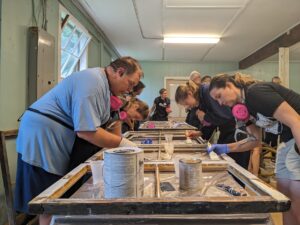
Wet Basement- Pet Predicament
- May 6, 2009
- 2:49 pm
- May 6, 2009
- 2:49 pm
 Challenges and Solutions- Craig Prince, Mason Trenching Company
Challenges and Solutions- Craig Prince, Mason Trenching Company
Second in Your Old House Workshop Spring Series
On April 13’09 the Landmark Society had its second session of Your Old House Workshop Series. The speaker for this session was Mr. Craig Prince— owner of Mason Trenching Company for over 30 years, a bonded , licensed and full service plumbing and excavation contractor.
The evening started with an inspection of the Stone Tolan House and the barn from the exteriors. Mr Prince talked about the drainage system of the house and explained few terms and issues involved when looking for leaks. It was interesting to learn that the downspouts of the house have expanded due to frozen water. He talked about tiger stripes as one of the red alerts, for water blockage in gutters.
Followed by the visual inspection of the house was Mr. Prince’s presentation, where he talked about the key sources and solutions for the treatment of wet basement. According to the American Society of Home Inspectors, nearly 60 percent of U.S. homes have wet basements. This is a humungous percentage, but if dealt with right knowledge many solutions can be corrected by homeowners themselves. There are many sources from which water can seep into the basements, they include: condensation— when moist, warm air hits cool foundation walls or un-insulated cold-water pipes, run-off—rainwater or melted snow that is not properly routed away from the house, subsurface seepage—high water table, broken underground water pipes, root filled storm, sanitary sewers, failed drywells and footing drains clogged with sand.
Each source of water has to be treated accordingly, for water coming through condensation; the solution is to air out windows, run fans and install a dehumidifier. Another effective solution is to damp-proof walls with a waterproof coating, such as UGL’s DryLok water proofer, Xypex’s Hi-Dry or Conproco –a hydraulic cement based product. For run-off water, one needs to make sure that the gutter system is working properly. Some key questions need to be answered before arriving to a solution. They are as follows: Are the gutters and downspouts clogged with leaves? Can the water be heard in all downspout connections? Does the water come back out of the sewer? Some typical solutions to resolve the water leakages due to run-off water are: the installation of floating floor slabs, flooring drains, frenches drains, curtain drains and drywells.
It is important to know what kind of foundation the house has, in order to fix the problem. Older foundations in the Rochester area are mainly of three types: concrete blocks, solid poured concrete and fieldstone. The majority of the pre-1900 houses have fieldstone foundations. For such a foundation, the best protection against water is the exterior drainage system.
The treatment of sub-surface water seepage, involves high capital investment, so doing it right is very crucial. Having a good contractor, who is insured and guarantees his work, is the key to a successful job. A good contractor should try and rule out the simple things first rather than the most expensive shotgun approach. Mr Craig mentioned, “Water in basements is not rocket science but, it does require some common sense and basic time tested results. Some fundamental issues such as, gravity pipes require a pitch and must be checked with a laser or a level, sandy soils clog over time, should always be looked at first before treating sub- surface seepage.”
It was an extremely informative and educational session. The talk was successful and the audiences were highly appreciative of the speaker. We look forward to having you all for many more of these series and would very much appreciate your comments and feedback. Last but not the least we would like to thank our speaker Mr Craig Prince for his valuable time.
Posted by Nimisha Thakur, Preservation Associate
SHARE




